Our Montessori homeschool space has morphed over the years. We started with our homeschool space in our "unfinished" basement and then it slowly moved upstairs into the family room across from the kitchen. The family room works really well as a homeschool room because Little Bee can work on a project while I wash the dishes in the kitchen.
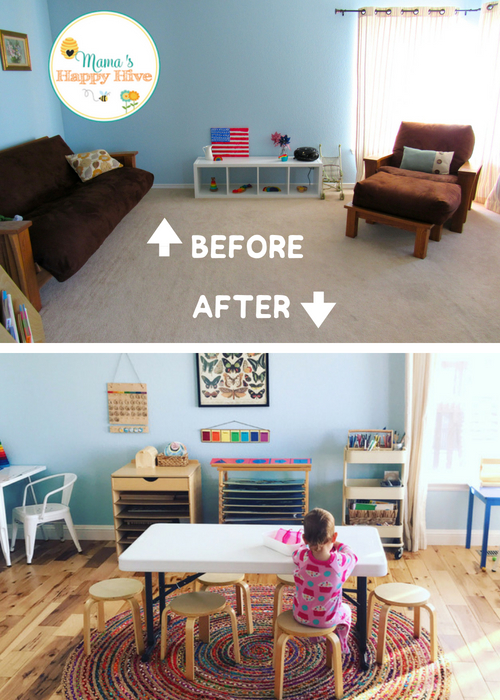
Our lives changed again and Sweet Bee (little sister) joined the family. I created a "baby/toddler" space in our homeschool room for her to use. This year, I also started a co-op once a month and invited other children to join us in our learning journey.
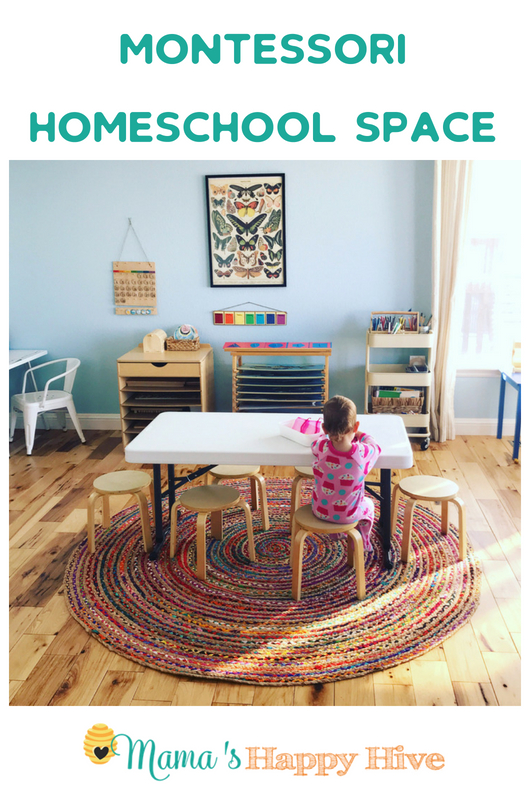
Overview of Our Montessori Homeschool Space
Our Montessori "inspired" homeschool space includes an open display bookshelf, monthly "themed" preschool shelf, table and chair for an older child, wooden perpetual calendar, framed art that can be changed every month, math/language shelf, Montessori continent map stand, IKEA art cart, community table (for co-op), table and chair for younger child, toddler shelf, and a baby/toddler work area.
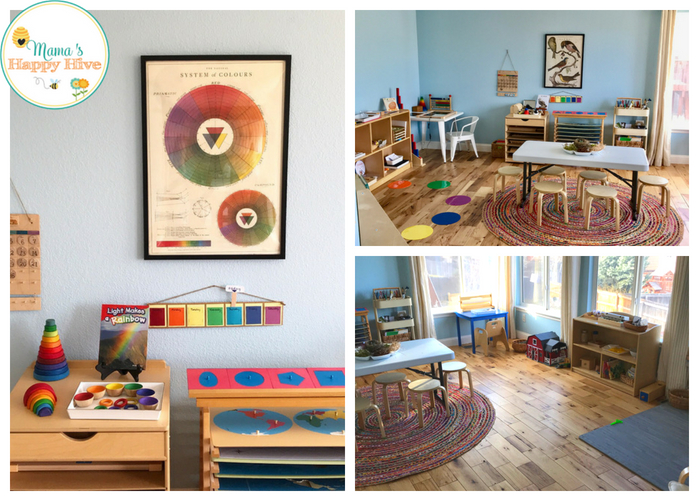
The plastic circle markers on the floor, in the photo above, are for the children to sit on and listen to story time and show & tell during co-op. We have children aged 6 months to 6 years old who attend our co-op.
Co-op Information
Our co-op has met four times this year and everyone has loved our time together. The children talk about the experience for days after we meet. We have studied the following topics: birds, rainbow colors, botany, and insects. The themes coming up are: ocean life, anatomy, autumn, and holidays.
This is the order of our meeting:
9:45 am - Parents with Children Arrive (parents quickly organize prepared supplies brought for co-op)
10:00 am - Children Sit Down in Circle for Story Time (read 1-3 stories) and Show & Tell Time
10:30 am - Themed Craft or Sensory Play or Science Experiment
11:00 am - Individual Work Time (shelf work)
11:45 am - Art and Journal Time (record what was learned)
12:00/12:30 pm - End (go home for lunch)
To help prepare the parents for co-op, I send out a monthly email with instructions and ideas to begin teaching and learning about the theme. For example, for the theme of insects we read books about the life-cycle of an insect. We did activities "before" co-op to learn the anatomical parts of an insect. Then at co-op we reinforced this with more hands-on work such as puzzles, play dough, art, and diagrams.
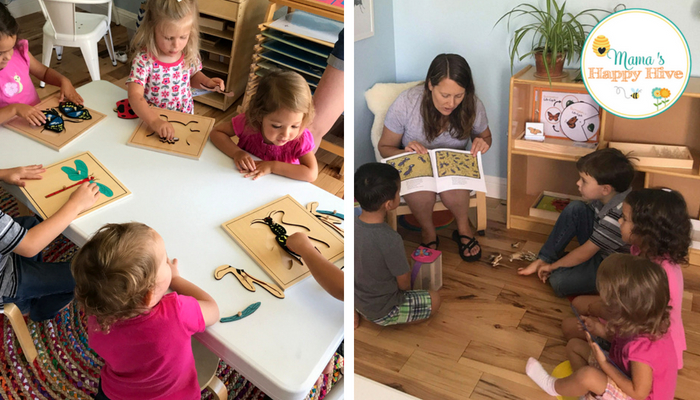
Preschool Themed Shelf
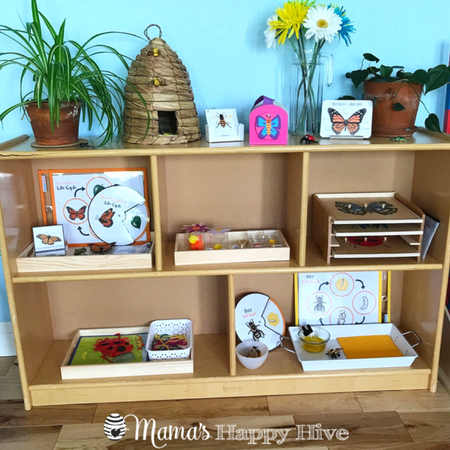
Each month for co-op, I arrange themed materials on our preschool shelf. This is an example of our preschool themed insect shelf in our Montessori homeschool space. On this shelf, I prepare nomenclature 3-part cards, parts of an insect diagram cards, life-cycle spinners with activities (using Safari TOOB Ltd figurines), matching work, fine-motor transfer work, Montessori insect puzzles, practical life lacing work, counting work, and fine motor water with dropper work (bees collecting honey for the hive). Also, included is a light table with x-ray images of insects, real "dead" insects to examine with magnify glass, and live butterflies who had just emerged from their cocoons.
Themed Bookshelf
We display all our "themed" books for our co-op each month in this open ECR bookshelf. We read the books and then decide which ones we like the best. Our favorite insect books are "Ten Little Ladybugs" and "The Bug Book" by Childcraft.
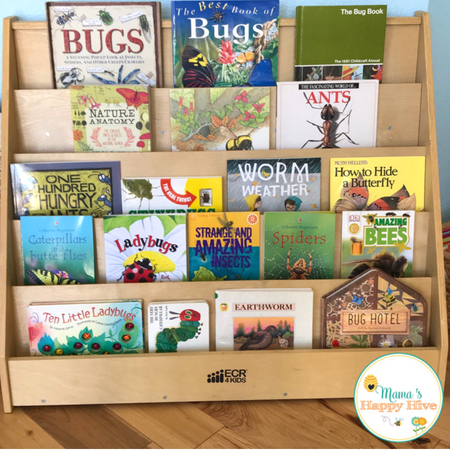
Homeschool Supplies and Organization
I keep myself organized for each monthly theme by separating each theme into clear plastic boxes. I rotate through similar themes yearly and expand on them as needed for the developmental needs of my children. For example: the first year we learned about birds, we took a nature walk to look for nests outside in the trees. We found a nest that had blown down onto the ground. Then we came home and built our own nest. The next year we dug deeper by learning the various names of birds, life-cycle of a bird, and also the anatomical parts of a bird. Then the next year we will buy binoculars and go bird watching. We will begin to learn about the songs and behaviors of birds and journal our observations.
Do you want to read more about how we organize?
Montessori (inspired) Homeschool Organization
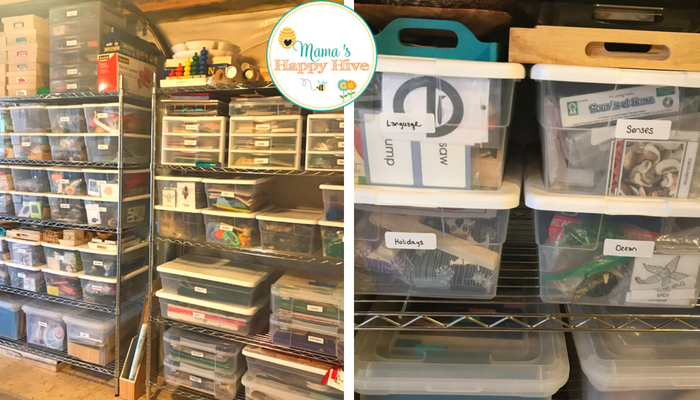
Art Cart
Journaling our observations leads me to our art cart. This art cart is from IKEA and is filled with art supplies. I keep the sharp watercolor pencils, scissors, and glass jars on the top shelf away from the babies reach. This doesn't mean that toddlers can't reach up and grab these materials. So when we have co-op, I do keep an eye out and the cart does have wheels if I need to move it out of the space. However, I haven't had any trouble with the toddlers/babies and the art cart. The lower shelves have materials that can be used by all ages - construction paper, watercolor paper, crayons, watercolor paint, and markers. (Markers are a grey area for younger children and sometimes I put these up high too).
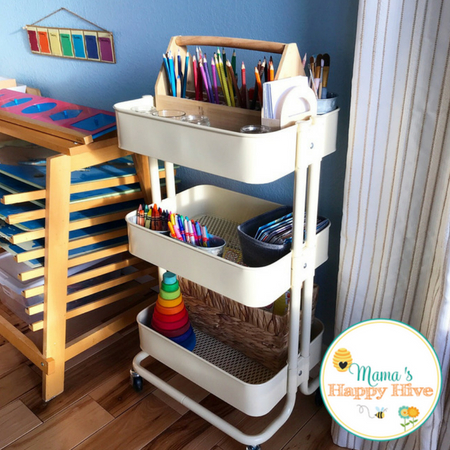
Baby/Toddler Space
This is our baby/toddler corner. I put developmentally appropriate toys on the shelves that help to attract the younger children and capture their attention. The babies really love the mirror, pull-up bar, and Pikler triangle for climbing. They are also fascinated by manipulative objects that they can put into a box or into their mouths.
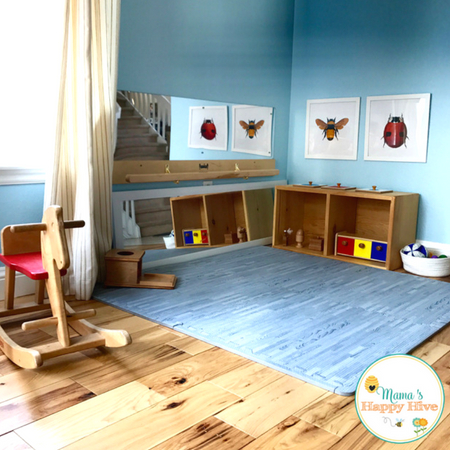
Mixed Ages in the Montessori Homeschool Space
I get a lot of questions about how to keep the younger children (2.5 years and younger) out of the preschool aged children's materials/space. My answer is that there is no guarantee that the younger children will stay in their designated corner. Most likely, they will not stay in their corner and will want to wander over to where the older children are working. My answer is to encourage the older children to help the little ones by being their teacher and a guide or example. I encourage the older children to show the younger children how to take out one work at a time and then to put the work back when they are done. The older children LOVE to be THE teacher and the younger children usually look up to the older children. This is a win-win situation. The parent or caregiver's role is to be patient, kind, and consistent. If the older children are not willing to lead, then the caregiver must model the good behavior and demonstrate keeping order in the homeschool space. That means continually redirecting the younger children to their work space and redirecting the older children to their work space. Or modifying the preschool work space for the younger children to be able to join.
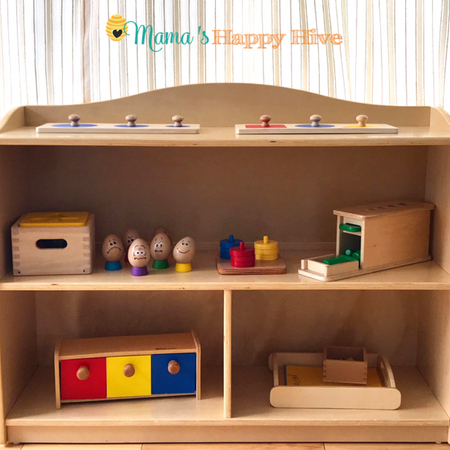
Language and Math Shelf
There are two more areas in our homeschool space that need some explanation. We also have a language/math shelf and geography (continents) map stand. These areas don't get used very much during our co-op meetings. However, these two shelves are used by Little Bee (5.5 years old) on his days off from school. He loves to work on the continent geography puzzles and he also loves working with letter sounds, writing his name, learning teen numbers, and writing numbers. So his language/math shelf has the materials that he needs to do this work.
The awesome feature of this shelf is the lid that opens and closes on top. Sweet Bee (2 years old) can not open the lid by herself. This is good news for Little Bee who likes to keep his pens, pencils, and sand tray intact. Otherwise, Sweet Bee will bite off his erasers, pull his pens apart, and distribute the sand throughout the house. This top lid works great to help keep the peace in our home.
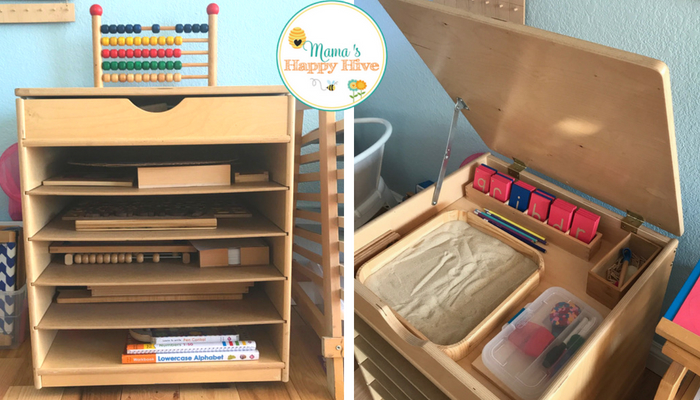
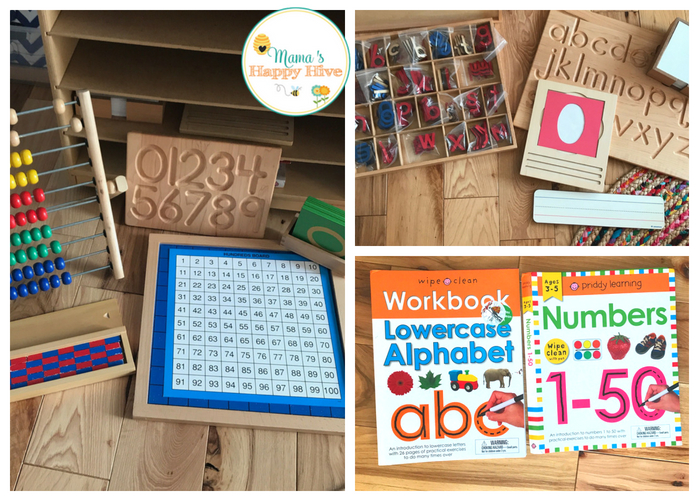
12 Months of Montessori - Montessori Homeschool Space
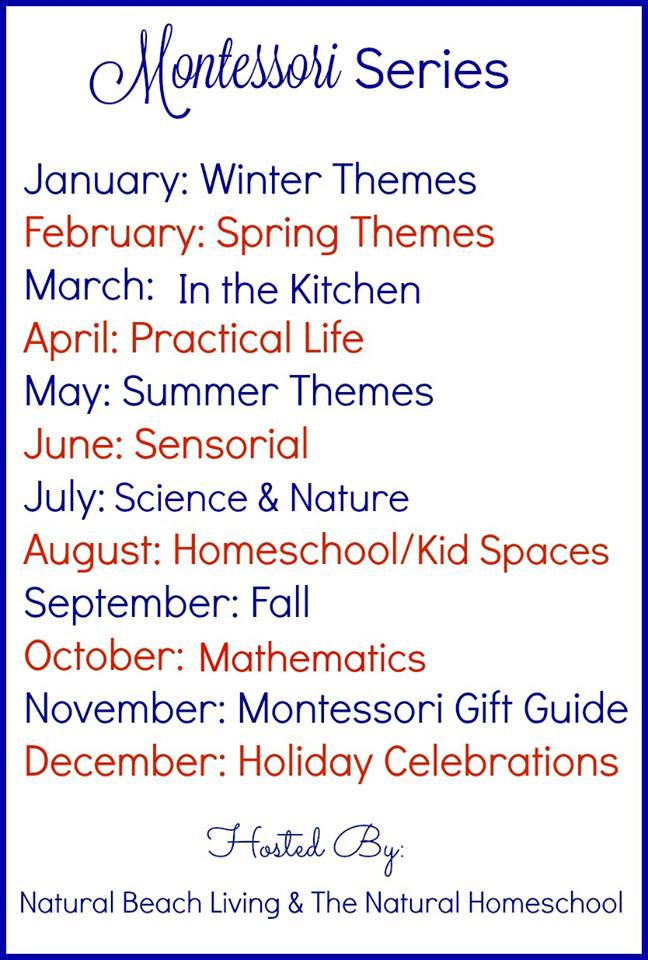
| Natural Beach Living
The Natural Homeschool Learning Spaces 2018 {Free Homeschooling Style Quiz} | The Natural Homeschool
How to Prepare Montessori Homeschool Spaces for Babies through First Graders| Living Montessori Now
Montessori Homeschool Space | Mama’s Happy Hive
Our Montessori Home Lately | The Kavanaugh Report


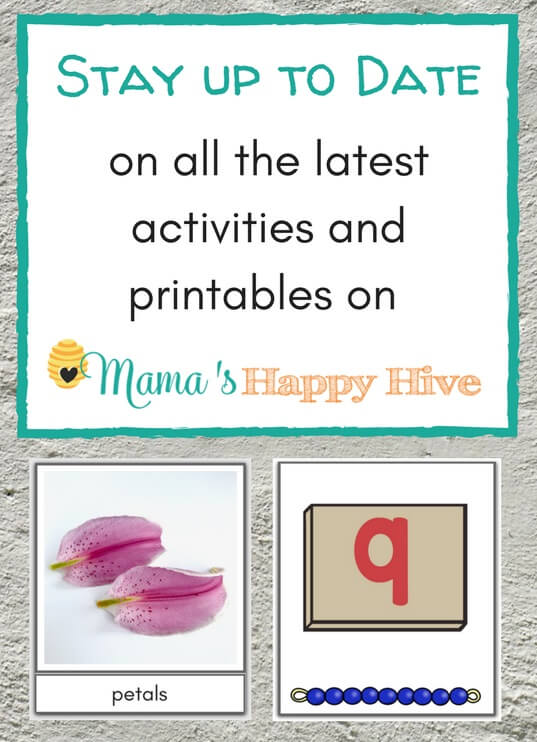
What an incredible array of learning methods and supplies you have compiled! You are an organized well-thought-out teacher! Your printables and other resource suggestions are easy to access and I appreciate how easy you make it for a parent to obtain the teaching and comfort items necessary for an ideal learning environment. Your website has a sweet and very caring vibe to it. Thank you!!